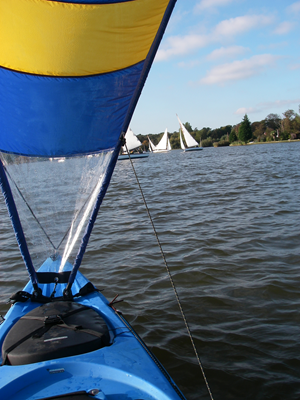Pacific Action PA_S010 1m Sit-On-Top Sail
We've had the Pacific Action Kayak Sail for quite a few years now and we've used it on several of our kayaks, the Ocean Kayak Trident 15, Scupper Pro and now the Ultra 4.3.

If you want to extend your kayak fishing experience or want to reach those far off marks with a little more ease, then it might be worth considering fitting a sail to your kayak.
The Pacific Action Sail we have was designed to fit the Ocean Kayak Prowler 13 and didn't require any additional harware to fit, however we weren't so happy with the control lines fitted around the perimeter of the cockpit so made a few alterations which I will come to later.
We have since fitted the same sail to a Ocean Kayak Trident 15 and more recently to the Ultra 4.3, both these kayaks required the addition of some Footman's Loops at the bow to attach the sail to the deck and a pair of Clamcleats to lock the control lines in the chosen position. We also added some deck loops to the Ultra 4.3 to attach the forward bungee at the bow and to clip the control line carabiners to the deck.

Footman's Loop

Deck Loops
Fitting the sail is relatively easy, webbed straps at the base of the masts are looped through the footman's loops on each side of the kayak and tightend so that mast foot is central on the deck. Laying the sail over the bow you then connect the bungee to the front rope handle of the kayak using the supplied carabiner, if you have a solid handle as on the Ultra 4.3 then fitting a deck loop is a good idea to clip the carbiner to.
The deck control line is designed to loop around the front of the cockpit, and at the time we purchased the sail it was specific to that model. We took a knife to this, cutting the line in the centre giving us two lengths of rope, the supplied carabiners were left one on each side and a rope ball fitted to the end of the line.
To control the sail and lock off a the chosen angle depending on the wind direction blowing against the sail we used our favourite cleats the 214 and 213 low profile ones we have also used on our anchor trolley this time with the opening facing up and the pointed section facing towards the stern, this allows you to drop the rope and tug down to lock, a quick tug up on the line releases.
 Clamcleat 214
Clamcleat 214
What happens when you don't want to sail, pull down on both the control lines and grab hold of one of the masts, then the other, bringing them both together, wrap the sail cloth around the two masts and then the control lines around the cloth to keep it all neat, tie off to one side of the kayak, preferably the opposite side to your anchor trolley.
When you want to set sail, simply untie keeping hold of both control lines slowly release the two masts... your off.
With this style of sail you are limited to the direction you are able to sail, this is not an upwind sail its design is best for broad reaching and down wind sailing, although with a little practice you can sail beam reach (across the wind) and possibly very slightly tighter to the wind allowing yourself to make a little progress up wind.

I have to admit I find sailing generally more relaxing with a rudder, but this is not a must, you can easily steer using your paddle. In gusty or strong wind conditions I would strongly advise keeping hold of your paddle and using it to brace if required should you be hit with a strong gust, its also advisable to be leashed to your kayak in some form its not going to stop should you fall overboard, I use a Palm tow line which is stored in a belt, the line pays out should I fall overboard.

Palm Tow Line
Size wise there are three models within the Pacific Action range available for Sit-on-Tops starting at the 1m (11ft sq), 1.5 (16ft sq) and the huge 2.2m (24ft sq), it all depends on how brave you are really, me I'm more than happy with the 1m version, its controllable in very strong winds yet still big enough to keep me moving in a light breeze, if the wind is very light, I paddle!
